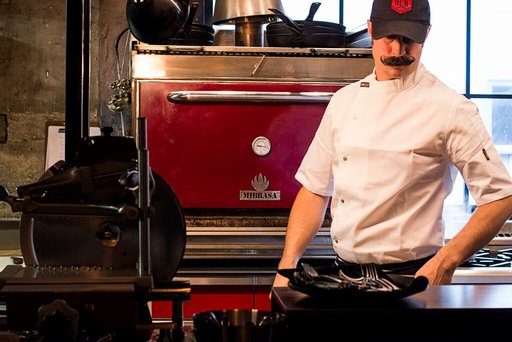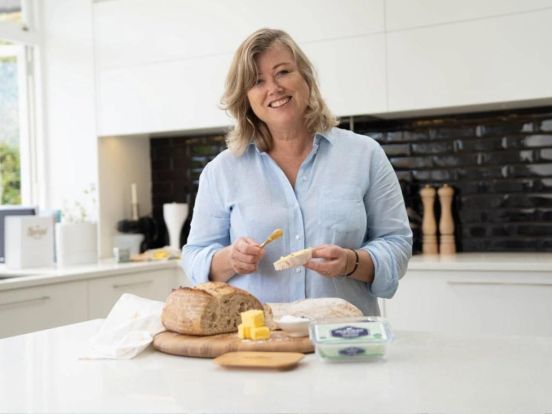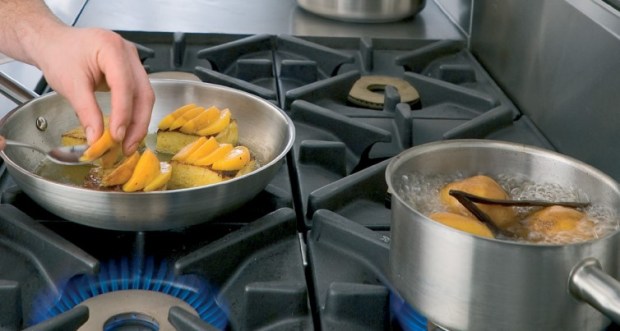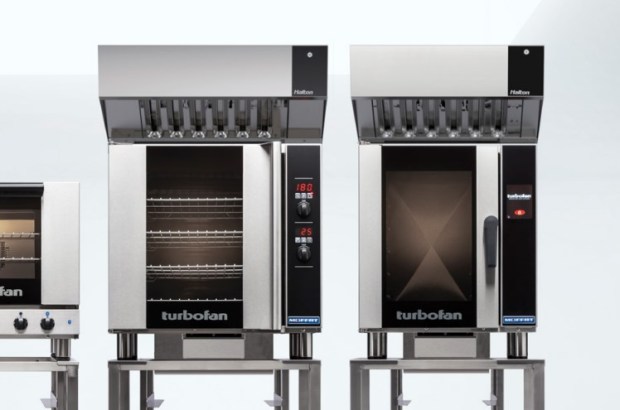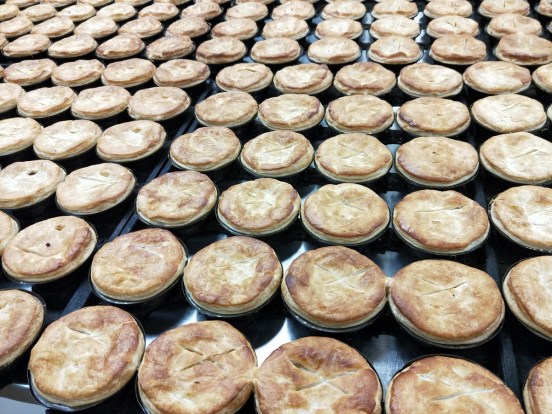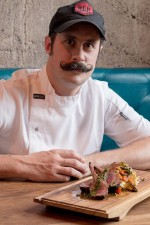 It’s getting smoky out there. Charcoal ovens, wood fire grills and darn big smokers are the raging hot cooking things, it seems, as smart new restaurants get fitted out around the country. Essentially, however, decisions about kitchen design and equipment installation start with deciding the restaurant concept, then the menus needed to achieve that concept, as Kathy Ombler learned.
It’s getting smoky out there. Charcoal ovens, wood fire grills and darn big smokers are the raging hot cooking things, it seems, as smart new restaurants get fitted out around the country. Essentially, however, decisions about kitchen design and equipment installation start with deciding the restaurant concept, then the menus needed to achieve that concept, as Kathy Ombler learned.
Blair Clement has had a lot of new fit outs to think about. He oversees many of the Macfarlane group of restaurants and cafes, mostly in Taranaki but increasingly nationwide and says he currently has responsibility for about ten kitchens. Of all of them, the one that has given him the biggest buzz is the Social Kitchen, which opened in New Plymouth late last year and for which Clement is also general manager.
The main reason for the buzz, he says, is the Mibrasa® charcoal oven we’ve installed. “This oven is a first, so learning how to get the best results was by trial and error. That’s been really exciting and it’s doing great things.” Why the new Mibrasa®? Let’s back pedal a touch. “When we start a new place we think about the restaurant concept we want and what menus we need to achieve that, then we build the kitchen to suit,” says Clement. “For example I’m now working on an Italian-themed restaurant so obviously that will have a pasta cooker in the line.
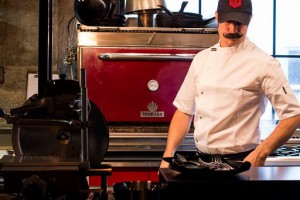 “At Social Kitchen we wanted a relaxed, shared dining, ‘extension of our own homes’ concept.” Add to that a South America influence and natural flavours and, well, a charcoal oven seemed just the fit.
“At Social Kitchen we wanted a relaxed, shared dining, ‘extension of our own homes’ concept.” Add to that a South America influence and natural flavours and, well, a charcoal oven seemed just the fit.
“The big point of difference for Social Kitchen is our Mibrasa® oven,” Clement adds. “All our meats are cooked over charcoal as opposed to gas or electricity. So you get your smoke infusing through the meat and adding flavour. Plus it’s a dry heat compared with the wet heat you get from gas, so you get beautiful caramelisation on the outside, and better colour.”
As the Social Kitchen website says: ‘meat dreams are made of these’ (we’re talking mains such as Taranaki Ruby Fields free range pork belly, Taranaki Green Meadows skirt steak, or porterhouse, and Wairarapa lamb rack as a whole or half).
“The oven operates at around 300 to 450°C, at 11am we’ll load it up,” says Clement. “It’s very quick to heat up, then we’ll maintain the heat for the entire day. Generally it’s not hard to maintain the temperature. We had to learn by trial and error, we took it up too high once, that wasn’t ideal.
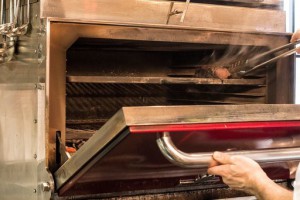 “It’s the biggest of its kind and very efficient. We have a 90-seater restaurant and have never struggled with capacity. A key thing is that we are combining the oven and chargrill. If you take a half kilo of ribeye, for example, conventionally you sear it off then put it in the oven and that might take 20 minutes. With the Mibrasa® we can do both those elements of cooking at the same time, so it’s ten minutes max.”
“It’s the biggest of its kind and very efficient. We have a 90-seater restaurant and have never struggled with capacity. A key thing is that we are combining the oven and chargrill. If you take a half kilo of ribeye, for example, conventionally you sear it off then put it in the oven and that might take 20 minutes. With the Mibrasa® we can do both those elements of cooking at the same time, so it’s ten minutes max.”
It’s also energy efficient, he adds. “It’s probably dropping our gas bill by a third. Obviously we have to buy the charcoal but we can use the oven for slow cooking as the heat dies down. For example we have brisket on the menu that requires long slow cooking so at the end of the night, when we let the charcoal die down, we have the brisket all prepped and put it in the oven overnight. It sits there all night long, slowly cooking, and it’s just melt in your mouth.”
The smoky theme continues in dare we say, the ‘Big Smoke’, Auckland. At the new Woodpecker Hill, in Parnell, chef Che Barrington is producing low, slow cooked barbecue meat in a custom designed smoker, engineered just for the restaurant. Again – the kitchen equipment meets the concept. It’s actually a touch of fusion that Barrington aims to produce; smoky barbecue meat (such as 14 hour smoked beef brisket and coconut-braised beef rib) comes dressed with his trademark spicy and zingy Asian flavours.
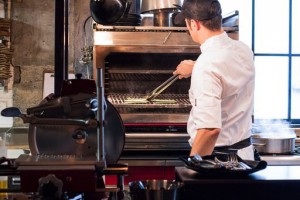 Celebrating fresh seafood is the mantra at the new Regatta Bar & Eatery, appropriately so given its seaside Takapuna Beach location. A wood fired oven and innovative internal smoker in a new-style combi oven are key features in the open-plan kitchen. Market fish is delivered through the day and displayed on ice on the kitchen pass. Three ‘market boards’ describe the species just ‘landed’, and diners can watch the fish they order going straight to the pan, combi oven with smoker or the wood fired oven. “This is the most exciting fit out I’ve been involved in, given the approach to seafood and adding theatre to the dining experience. It celebrates the engine room where the magic happens, and shares this aspect of dining with the customers,””says Regatta director, Andy Ruzich.
Celebrating fresh seafood is the mantra at the new Regatta Bar & Eatery, appropriately so given its seaside Takapuna Beach location. A wood fired oven and innovative internal smoker in a new-style combi oven are key features in the open-plan kitchen. Market fish is delivered through the day and displayed on ice on the kitchen pass. Three ‘market boards’ describe the species just ‘landed’, and diners can watch the fish they order going straight to the pan, combi oven with smoker or the wood fired oven. “This is the most exciting fit out I’ve been involved in, given the approach to seafood and adding theatre to the dining experience. It celebrates the engine room where the magic happens, and shares this aspect of dining with the customers,””says Regatta director, Andy Ruzich.
Again, those smoky flavours feature. “Our kitchen boasts a Zesti wood fired oven with a grill plate that has an adjustable arm. This can raise or lower the grill, based on the heat required for what you are grilling. The oven is lined with fire bricks and has no gas appliance. A fire is lit every morning and burned down to a hot coal base for lunch service, and lit again mid-afternoon to prepare for dinner service.” He says the grill adds a wonderful, wood-fired smoky flavour to a range of dishes, including fish, prawns and steaks.
Another special installation at Regatta is the Alto-Shaam (Model CTP10-E), a combi oven that includes a new, internally built smoker. The unit is also efficient, says Ruzich. “It features a faster recovery mode which allows the oven to change temperatures drastically in extremely short periods of time. This increases the units functionality and gives us more flexibility.”
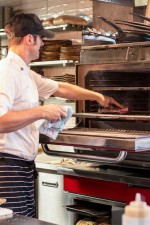 As with the Social Kitchen, it’s the restaurant concept that has driven design aspects at Regatta, notes Ruzich. “Achieving our vision of an open kitchen, where the chefs are in view of the diners, called for a solution with regards the traditional hanging (and view-blocking) heat lamps. Our innovative approach to overcome this was installing underfloor heating into the marble bench top, where the pass and the kitchen bench are brought together as one flush workspace. As the dishes are passed across from the kitchen they are kept warm on the heated marble. Only half the pass has this installed so that cold dishes and desserts can be presented without compromising the dish,” he adds.
As with the Social Kitchen, it’s the restaurant concept that has driven design aspects at Regatta, notes Ruzich. “Achieving our vision of an open kitchen, where the chefs are in view of the diners, called for a solution with regards the traditional hanging (and view-blocking) heat lamps. Our innovative approach to overcome this was installing underfloor heating into the marble bench top, where the pass and the kitchen bench are brought together as one flush workspace. As the dishes are passed across from the kitchen they are kept warm on the heated marble. Only half the pass has this installed so that cold dishes and desserts can be presented without compromising the dish,” he adds.
Back in Taranaki, Blair Clement says a key factor about kitchen design is how it’s going to flow.
“We think about how the flow is going to cope with the concept and menus we have in mind. When we’re looking at the plan we’ll think about where, for example, the chef is going to stand. Does he or she have enough room or too much room – if there’s too much that might mean an extra step from the hot lines to plating and that can really slow down service. So it’s thinking about how your staff can be quick and efficient. Obviously things like having under-bench fridges by the cooking line are going to help.
“Another key to good kitchen flows is doing the right staff preparation. There’s no point in staff not knowing what to do or where to go, it’s about having your staff well trained so they know what they are doing in the kitchen. We invest a lot of time and money to ensure that happens.”


